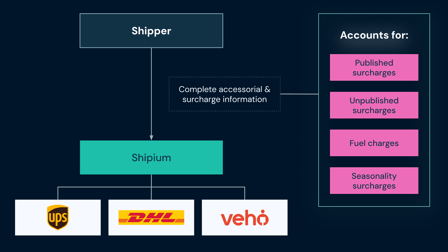The Value of Shipium’s Internal Rating Engine

Ever feel like you're playing a guessing game with your shipping costs? This all-too-common problem among shippers is driven by a wide range of factors — one of which is the reliance on carrier rating APIs during the rate shopping process, which can cause inaccurate selection and discrepancies between expected and invoiced rates.
Let's take a look at the common issues that make shipping rates unpredictable, and how Shipium’s Internal Rating Engine can help you get a handle on them.
The Problem With Relying on Carrier APIs
Most shippers rely on carrier APIs to get their rates, but these APIs have some shortcomings across two main categories that can contribute to inflated costs.
Inaccurate rating:
- Rate Variability: Carrier APIs may return dynamic rates that fluctuate based on volume agreements, fuel surcharges, or seasonal changes, making cost prediction inconsistent and inaccurate.
- Contracted vs. Retail Rates: Some APIs return general retail rates instead of contracted rates based on a shipper’s negotiated agreements, leading to discrepancies in cost calculations.
- Lack of Historical Pricing: Most rating APIs return only current prices, making it difficult to analyze past rate trends for cost optimization.
- Complex Rules & Restrictions: Carrier-specific business rules (e.g., dimensional weight calculations, zone-based pricing, or restricted services for certain locations) can be complex to handle from response data and real world application for fulfillment selection.
- Address Validation Dependencies: Many rating APIs require precise address validation before returning rates, adding another dependency to the integration.
Response structure and API performance:
- Inconsistent Response Formats: Different carriers use different API structures, requiring custom parsing logic for each integration.
- Inconsistent or Limited Response Data: Some carrier APIs may not provide all necessary details (e.g., full transit time breakdowns, detailed service options, or surcharges), leading to gaps in a complete rate for a given shipment evaluation.
- Authentication & Rate Limits: Many APIs require authentication and have rate limits, restricting the number of requests per minute or day, which can be problematic for large-scale operations
- SLA and Downtime Issues: API availability isn’t always guaranteed, leading to potential disruptions in rate fetching during system outages or maintenance windows.
All of these issues can lead to surprise costs and make it difficult to accurately budget for shipping.
The Benefits of Shipium’s Internal Rating Engine
Shipium solves these problems with an advanced internal rating engine. Rather than acting as a pass-through to various carrier APIs, our platform uses internal rate modeling to give you an accurate, real-time picture of your shipping costs.
Benefits include:
Invoice-Accurate Cost Estimation
As mentioned above, Carrier APIs often return list rates or simplified estimates, which don’t account for:
- Contracted discounts
- Fuel surcharges
- Peak season fees
- Address correction fees
- Residential/commercial delivery adjustments
Shipium’s rating engine leverages historical invoice data, negotiated rate tables, and dynamic surcharge calculations to produce cost estimates that reflect actual invoiced amounts, reducing billing surprises.
Consistency & ReliabilityCarrier APIs are subject to downtime, slow response times, and rate variability, making real-time pricing unpredictable. Shipium’s rating engine infrastructure operates independently of carrier API availability, ensuring consistent performance without API rate limits or outages. Shipium’s rating engine infrastructure pre-calculates rates and stores pricing models, allowing for near-instant rate lookups with optimized performance.
Multi-Carrier & Mode FlexibilityCarrier APIs can lock shippers into their ecosystem, making it difficult to compare across multiple carriers efficiently. To combat this, Shipium’s rating engine normalizes rate structures across FedEx, UPS, regional carriers, and LTL providers, making cross-carrier comparisons seamless.
Enhanced Business Logic & CustomizationCarrier APIs do not account for internal business rules, such as:
- Preferred carrier/service for specific routes
- Minimum margin requirements
- Compliance with customer SLAs
Shipium’s rating engine allows for custom logic, ensuring the best carrier decision based on cost, performance, and strategic priorities.
Historical Rate Tracking & Predictive AnalyticsCarrier APIs only return current rates, making it impossible to:
- Analyze historical cost trends
- Predict future surcharges
- Optimize contract negotiations
Shipium’s rating engine models use historical rate data and predictive analytics to identify cost-saving opportunities and prevent invoice discrepancies.
Transparency & AuditingCarrier APIs don’t always expose full breakdowns of how rates are calculated. Shipium’s rating engine provides a transparent cost breakdown, helping finance teams reconcile invoices and flag unexpected cost variations.
Scalability & Performance OptimizationCarrier rating APIs require separate calls for each service level, carrier, and surcharge, leading to slow response times and bottlenecks at scale. Shipium’s rating engine infrastructure consolidates logic and rate calculations in a single request, delivering faster, more efficient responses — even for high-volume shipments. Instead of waiting on multiple API responses, Shipium computes complete, optimized rates instantly, improving operational efficiency and user experience.
By combining an extensive network with a powerful, smart rating engine, we help you get a clear, predictable view of your shipping costs. No more guesswork, no more surprises — just smarter, more efficient shipping.
A Note on Our Pre-Integrated Carrier Network
Shipium is powered by a pre-integrated carrier network that covers 99.2% of North American parcel shipments. By leveraging virtualized contracts and working with our expert services team, customers can integrate new carriers in a matter of hours, rather than days or weeks.
We’re also constantly expanding this network based on customer feedback. If a specific carrier is required but not yet supported, we can onboard them at no additional cost.
Wrapping Up
Having a clear understanding of carrier rates is difficult at scale, but critical for overall cost management. The traditional approach of relying on carrier APIs with their hidden costs and performance bottlenecks can prevent optimization in this area.
By adopting a modern platform like Shipium, you can move toward a more efficient and cost-effective strategy.
If you’d like to dive into this topic in more detail, our CEO and ex-Amazon technology executive Jason Murray is hosting a LinkedIn Live discussion on August 28th to cover it in more depth — register here if interested!



